Wondering how to choose a WordPress theme? There are tens of thousands of themes out there…how do you pick just one? Talk about a needle in a haystack!
As your WordPress site’s foundation, your theme plays an important role not just in how your site looks, but also how well it functions and performs.
Pick a good theme and your site will look great and load quickly on all devices. Pick a bad theme and, well, you won’t be so lucky.
Here’s the good news…
You don’t have to leave the quality of your theme up to chance. By systematically asking yourself a set of questions, you can determine whether a theme is a right option for your site before you commit to it.
Keep reading to learn everything you need to know about how to choose a WordPress theme that will set your site up for success.
Let’s dive right in.
What Is A WordPress Theme Really, Anyway?
Put simply, your WordPress theme controls how your WordPress site looks.
If you’re reading this post, you probably have a decent grasp on what a WordPress theme is at a high level, but we still think that distinction is pretty important because sometimes people think a theme should do too much.
We’ll cover this later on, but your theme really is just supposed to handle how your site looks, not what functionality your site has.
For example, if you want to create an eCommerce store, you’ll need a plugin to create products and manage orders. Then, your theme makes sure that the content from that plugin looks pixel-perfect. But your theme should never add the eCommerce functionality by itself!
While eCommerce themes will offer deeper integration and support for plugins like WooCommerce, and Easy Digital Downloads. The same cannot be expected with blog themes.
15 Questions To Ask Before Choosing A WordPress Theme In 2025
Ok, so what should you actually look for when you go to choose a WordPress theme? That’s the bulk of what we want to cover in this post, so we’re doing to dig in pretty deep here.
Let’s start off simple…
To frame your search, think about what you want to achieve with your website.
Is it a blog? A portfolio? An eCommerce store?
What’s it about? Business? Travel? Photography?
Because WordPress is so popular, you can find WordPress themes for all kinds of different “niches”. Or, you can also find multipurpose themes that you can adapt to any type of website. For example, the Astra theme offers pre-built website templates for a huge variety of niches.
Beyond the niche, also think about what type of “look” you want. Do you want that modern Scandinavian design? Or do you want something a little more old school?
These questions will help shape your search. Then, once you put together some themes that you’re interested in, here are the specific questions you should ask to make sure your chosen theme is going to set your site up for success…
Questions To Ask About The Theme Itself
First off, you’ll want to take a deep hard look at the theme itself.
If you’re looking at a free theme, you can install it on a test site. For premium themes, you can usually find a public demo to play around with. The theme’s website/documentation will also come in handy in a few situations.
Once you have that, here’s what to investigate…
1. Does It Work Well On All Devices? (Responsive Design)
Responsive design means that your chosen theme will automatically adjust so that it looks great on different devices (like a smartphone vs a laptop).
In 2020, pretty much every theme offers responsive design at some level.
But here’s the thing:
Not all responsive design is equal.
That is, even if a theme does automatically adjust itself for different devices, that doesn’t mean it will actually look good on all devices.
So – you need to do a little digging. If you have your smartphone handy, you can pull up the theme demo on your smartphone. Or, you can use a tool like Responsive Design Checker to test straight from your browser:

Check the mobile version of your theme for little things like:
- How the menu works
- What your blog posts look like
- How the font is
- Etc.
Basically, you want to make sure that anyone visiting from a smartphone is still going to have a great time on your site.
2. Does It Load Quickly?
How quickly your website loads has a big effect on everything from user experience to conversion rate.
As your site’s foundation, your theme is going to have a huge effect on your site’s performance.
Big bloated themes will make your site load slow, while optimized themes will ensure that it loads fast.
So…how do you choose an optimized theme?
First, you can check Tidy Repo’s huge performance test of 100+ themes. While this database doesn’t cover every theme, it provides a ton of data for many popular themes.
For example, you can see that the Astra theme is one of the fastest WordPress theme out there:
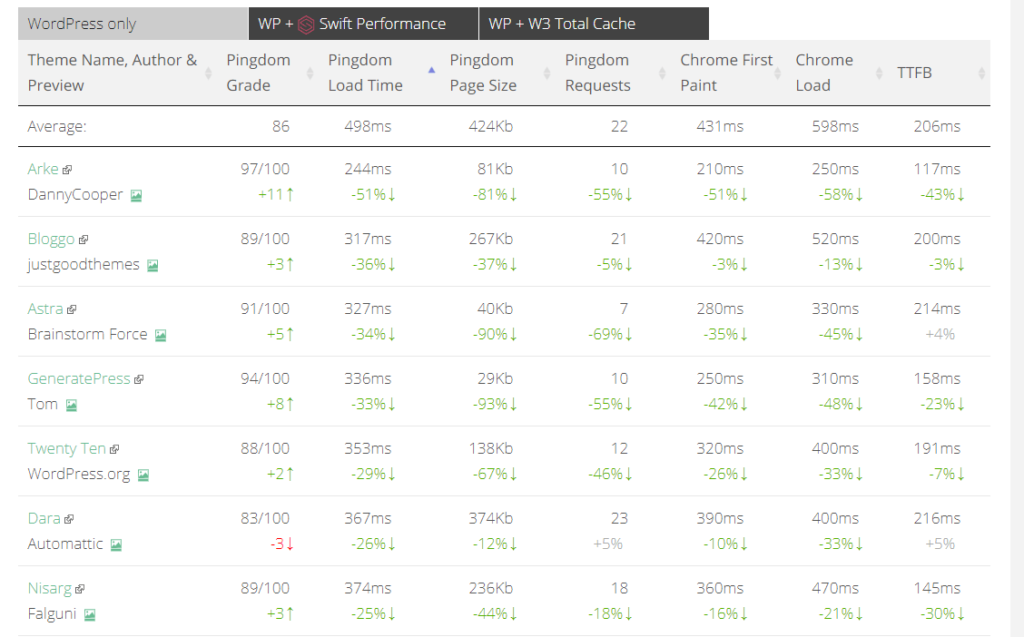
If that’s not an option, you can install the theme on a test site and run some performance tests with Pingdom. Or, if it’s a premium theme, you can run the demo through Pingdom (this isn’t a perfect test – but it gives you a good idea).
Beyond just how quickly your site loads, you also want to check the file size and HTTP requests for each theme (fewer is better!). For example, the base Astra theme is under 50 KB in size, while bloated themes can easily get over 2MB by default.
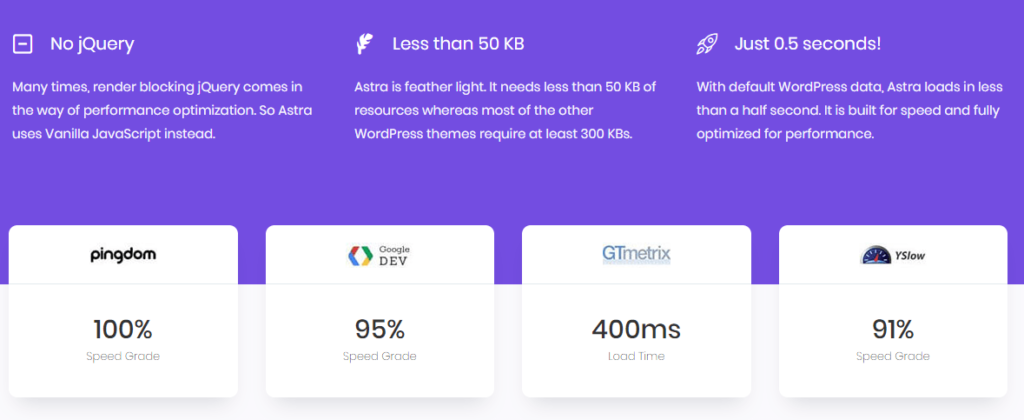
3. Are All The Little Design Elements Just Right?
A lot of this will be personal choice…
But when you’re deciding if you like a theme’s design, make sure you dig beyond the main page demo.
Consider things like:
- Blog post layout
- Typography, e.g. the fonts it uses
- Navigation, e.g. does it support a sticky header? Can you create a transparent header?
- Sidebars
- Widgets
Poke around every nook and cranny so that you know how everything looks.
Basically, you want to make sure that you love everything about your chosen theme’s design so that there’s no confusion later on.
4. Does It Work Well In All Web Browsers?
Beyond working great on different devices, your chosen theme also needs to look the same on different web browsers (e.g. Chrome vs Firefox vs Safari, etc.).
Now, if your theme is coded well, it should have no problems. But there are some quirks in how each browser handles websites that can cause issues in certain cases.
Don’t worry – you don’t have to install every single web browser on your computer. Instead, you can use a free tool like Browserling or Browsershots to quickly test all the popular browsers right from your own web browser:
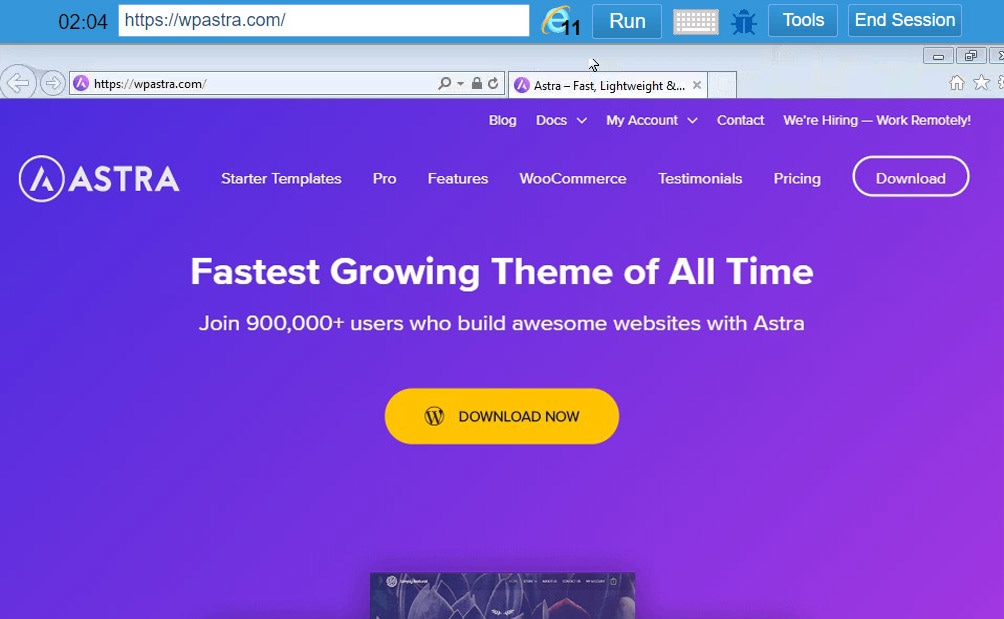
5. Is It SEO-Friendly?
There are a few things that go into making an SEO-friendly WordPress theme.
At a minimum, you’ll want to look for a theme with clean code, as that will ensure that your chosen SEO plugin is able to properly optimize your site, as well as that Google won’t have any issues crawling your site.
But some WordPress themes also go further and help you add proper schema markup to your to communicate extra information to Google (and help get your site those eye-catching site links or knowledge graph entries).
6. Is It Translation-Ready (If You’re Creating A Multilingual/Localized Site)?
Want to create a multilingual site? If so, you’ll want to make sure that your chosen theme is translation ready.
Usually, theme developers will tell you when your theme is translation ready. For example, we let everyone who is considering the Astra theme know that they also get access to the .po and .mo files for easy translation.
If you want to use your site with an RTL language, you should also make sure that your theme supports RTL text.
7. Is It Accessibility Ready?
Accessibility is about making your website available to all visitors, including people who need to use screen readers or other similar devices.
Try to find a theme that meets WCAG 2.0 guidelines, or otherwise advertises itself as having implemented accessibility best standards:
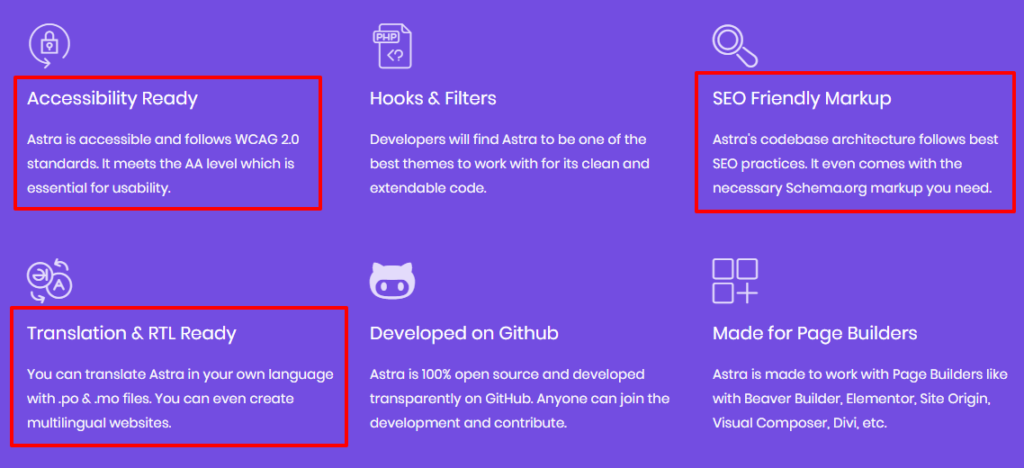
To test accessibility itself, you can use the free Web Accessibility Evaluation Tool. You probably won’t find a theme that gets a perfect score (and some errors are user error, like not adding image alt text). But ideally, you don’t want to see too many issues.
8. Does It Have The Plugin Integrations You Need?
If you’re just creating a simple brochure site, you might not need any special integrations.
But if you’re planning on creating a specific type of site, like an eCommerce store an online course, it’s better to find a theme that has a dedicated integration for your chosen tool.
For example, if you’re creating an online course, LifterLMS and LearnDash are two of the best LMS plugins. They’ll technically work with any theme. But you’ll likely have to add your own custom CSS to make them look good, which isn’t ideal.
As an alternative, you could pick a theme like Astra that has dedicated integrations for both LearnDash and LifterLMS to ensure that your courses look great without any special effort on your part.
9. Does It Use The WordPress Customizer?
The WordPress Customizer is a core function that lets you customize your theme using a real-time preview and simple controls:

In the past, themes used to give you a custom, non-visual interface to manage those settings. That’s not a good way, anymore. And in 2020, any quality theme really should support the WordPress Customizer.
Questions To Ask About The Non-Theme Stuff (Like Reviews And Updates)
Once you’ve given the theme’s demo and feature list a good hard look, you can put the demo away and look at some other important considerations like reviews, how often your theme gets updated, etc.
10. Does It Have Good Reviews?
This one is pretty obvious – but reading reviews from other users are one of the best ways to analyze a theme’s quality.
Most popular theme marketplaces include public reviews.
For example, you can find reviews at WordPress.org:
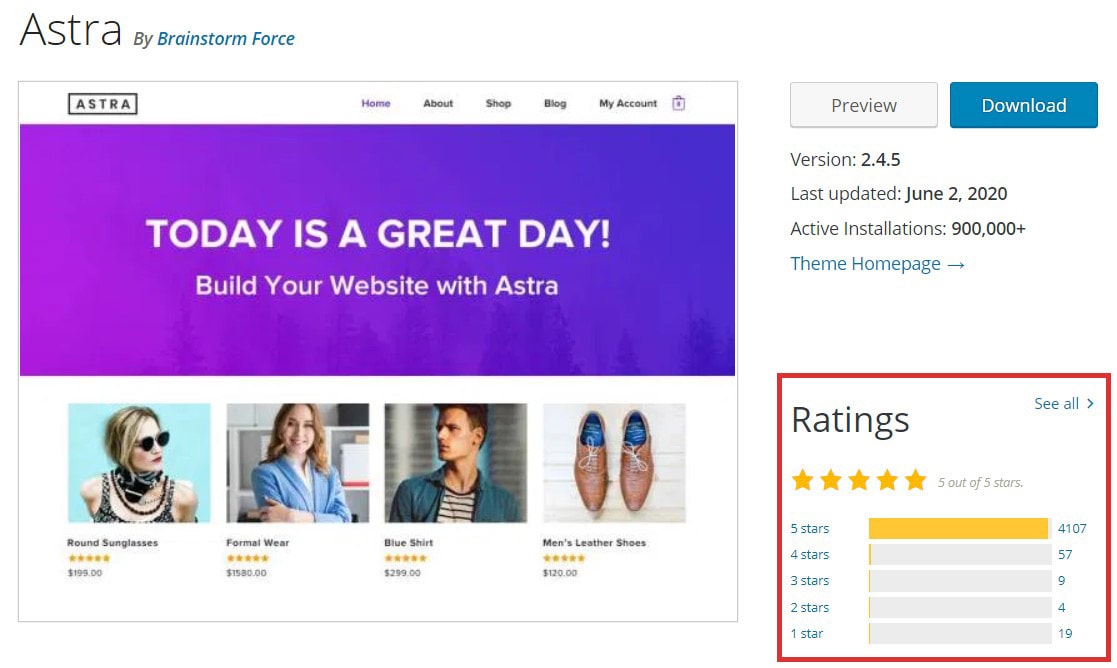
And Envato also includes reviews that you can access via the sidebar.
Don’t just look at the rating star number, though. You should also dig in and actually read the comments, as this will give you a better look at the theme’s pros and cons.
11. Does The Developer Regularly Update The Theme?
The WordPress software is constantly changing and being updated. So if you want to ensure that your theme continues to work well, it’s important that the developer keeps it updated.
Again, this is information that you can publicly find at most marketplaces.
For example, WordPress.org shows it on each theme’s page:

And you can also find it at Envato.
If the theme hasn’t been updated in the last ~6 months, you should definitely stay away. Most quality developers push out updates every few months.
12. Does The Developer Have A Good Reputation?
Speaking of quality developers, most developers release multiple themes or WordPress products. So if the theme itself doesn’t have a lot of reviews, you can always try to gauge a developer’s reputation by looking at the track record of their other products.
13. Will You Get Good Support?
No matter how well-made your theme is, you’ll still run into some situations where you need support. So – make sure the developer of your theme is ready to offer it!
Check the support policy to learn:
- How long you get support for
- What channels you can get support from
- What types of issues fall under the support policy
For example, some developers force you to use a public support forum for help, while others offer one-to-one private support. That’s important to know, as it will affect the level of support that you get.
14. Is There Quality Documentation For Self-Help?
You don’t want to have to ask support a question every single time you hit a snag. Instead, it’s usually much quicker to fix the problem yourself by consulting the theme’s documentation.
But…that only works if the theme actually has good documentation! So before you make your purchase, poke around the documentation and make sure it covers all the important stuff:

Some themes will also offer video tutorials, which is a big bonus if you’re a visual learner.
15. Is There A Good User Community?
Finally, quality WordPress themes often develop user communities that can also be a huge source of help and inspiration. While this one isn’t a must-have, it’s a big bonus if your theme has an active community.
You can often find these communities on Facebook, though your theme might have an active forum community, too:
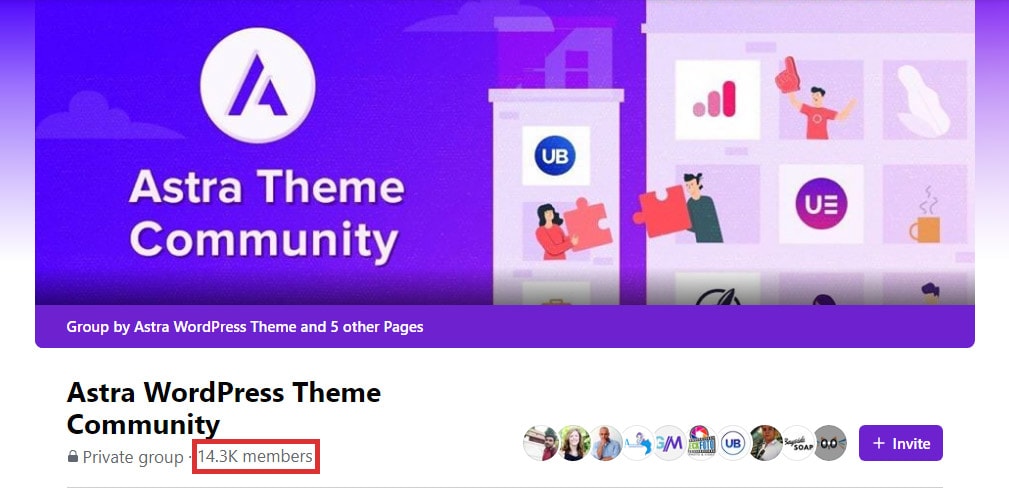
As another bonus, a large, active community also helps ensure that your theme will continue to receive updates and improvements, which is always a good thing!
Don’t Pick A Theme That Tries To Do Everything!
We’ve kept things positive above, but here’s one thing you don’t want to do:
Choose a theme that offers every single feature in the world built right into the theme.
While it might be tempting to find a theme that can do everything-and-the-kitchen-sink without needing any third-party plugins – that’s really not a good idea.
WordPress themes themselves are not supposed to add functionality to your site. Instead, that’s what plugins are for.
This is a very important best practice in WordPress because it ensures that you’re never “locked in” to using your theme. And there are all kinds of features that you’re better off leaving to plugins.
For example, it’s actually not a good thing if your theme gives you its own shortcodes.
Why?
Because if you ever change themes, all of those shortcodes will stop working – yikes!
Instead, it’s better to pick a dedicated shortcode plugin to use. That way, your shortcodes will still work even if you change themes.
Similarly, you do not want a theme with its own built-in page builder. If you want to use a page builder, you’re better off using a theme that’s built to work well with one of the many third-party page builder plugins like Elementor or Beaver Builder.
Free WordPress Themes vs Paid WordPress Themes: Is There A Difference?
While some people will make broad statements about premium themes being “better”, there’s no universal difference between free themes vs paid themes. You’ll find high-quality free themes and low-quality premium themes (and vice versa, of course).
Additionally, many themes come in both a free lite version and a premium Pro version. That’s how the Astra theme works – you can download the free version at WordPress.org, but then you can also extend that free version with premium functionality.
The core theme is the exact same between the free and Pro versions, so you won’t find any difference in code quality or optimizations.
But if we had to draw a few generalizations, we’d say there are a couple of reasons to consider the premium version of a theme:
- Often more integrations and customization options – premium themes will often get you access to more integrations and customization options because the premium price lets the developer invest more time into little nitty-gritty things.
- Better support – when you pay for a theme, you usually get 12 months of premium support. While some developers do often support for free themes, it’s not universal. And even if it is offered, you probably won’t get as much attention as a paying customer.
- Better longevity – if there’s money coming in, theme developers are more likely to keep developing the theme.
Again, these are all generalities, not hard rules.
How To Install And Use Your Chosen WordPress Theme?
Ok, so found the perfect WordPress theme – now what? In the next few sections, we’ll cover how to install your WordPress theme, as well as some best practices for using your WordPress theme or moving to your new theme from an existing theme.
How To Install A WordPress Theme?
To install your chosen theme, go to Appearance → Themes in your WordPress dashboard. Then, click Add New:
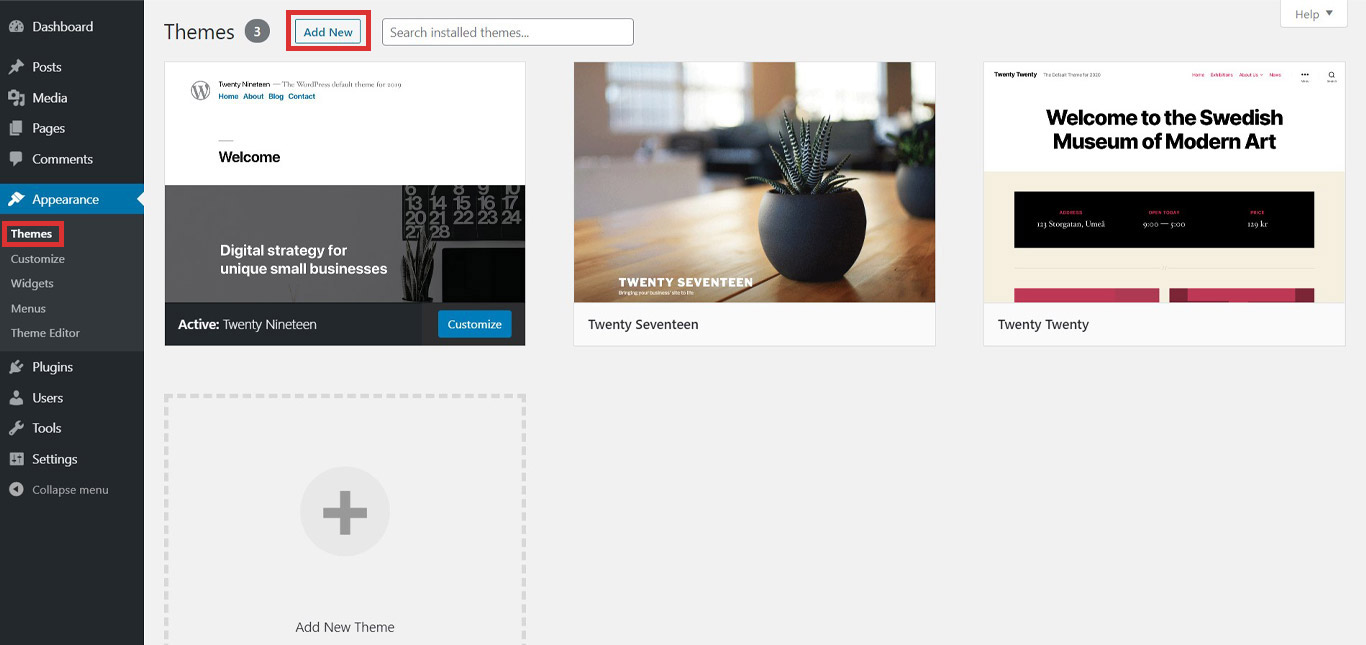
If your theme is listed at WordPress.org, you can search for it by name and click Install.
If you purchased a premium theme, though, you’ll need to click the Upload button and upload the zip file that you got with your purchase:
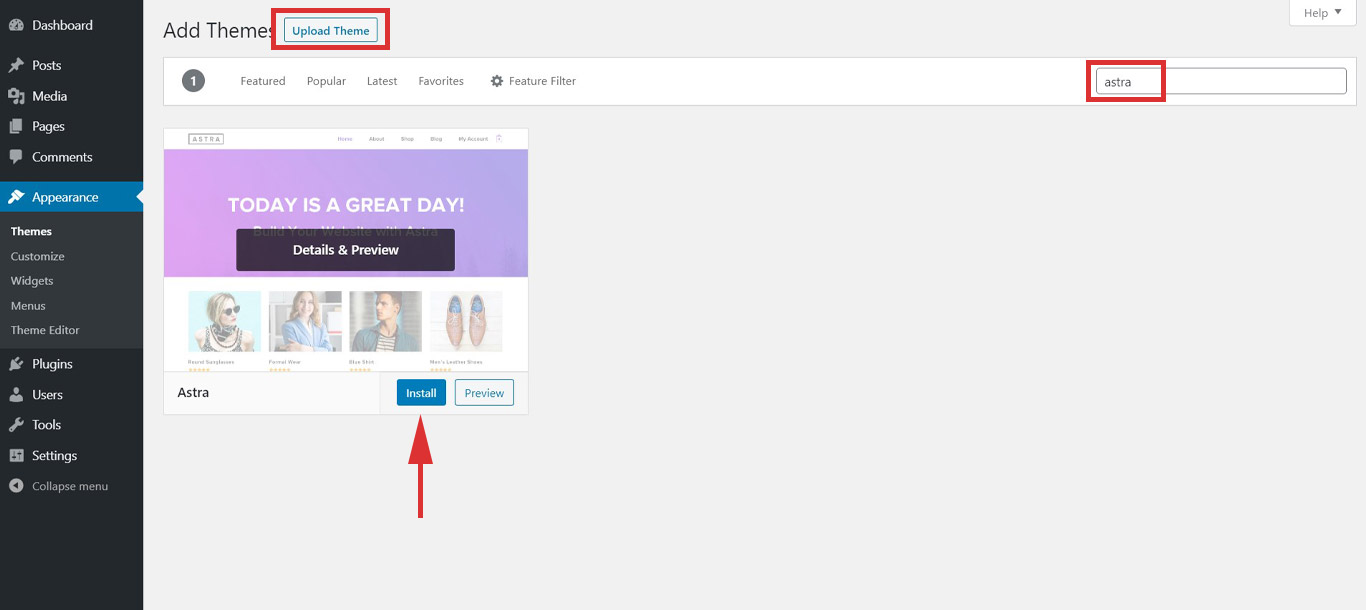
Use A WordPress Child Theme, Too
A WordPress child theme is an important best practice. Basically, it creates a safe “child” version of your theme that you can edit.
This is important because if you try to manually make any edits to a parent theme’s code, those edits will be overwritten every time you update your theme.
All you need to do is create your child theme using a tool. Then, you can install it like any other theme.
Some developers will give you a tool to help you create a child theme:
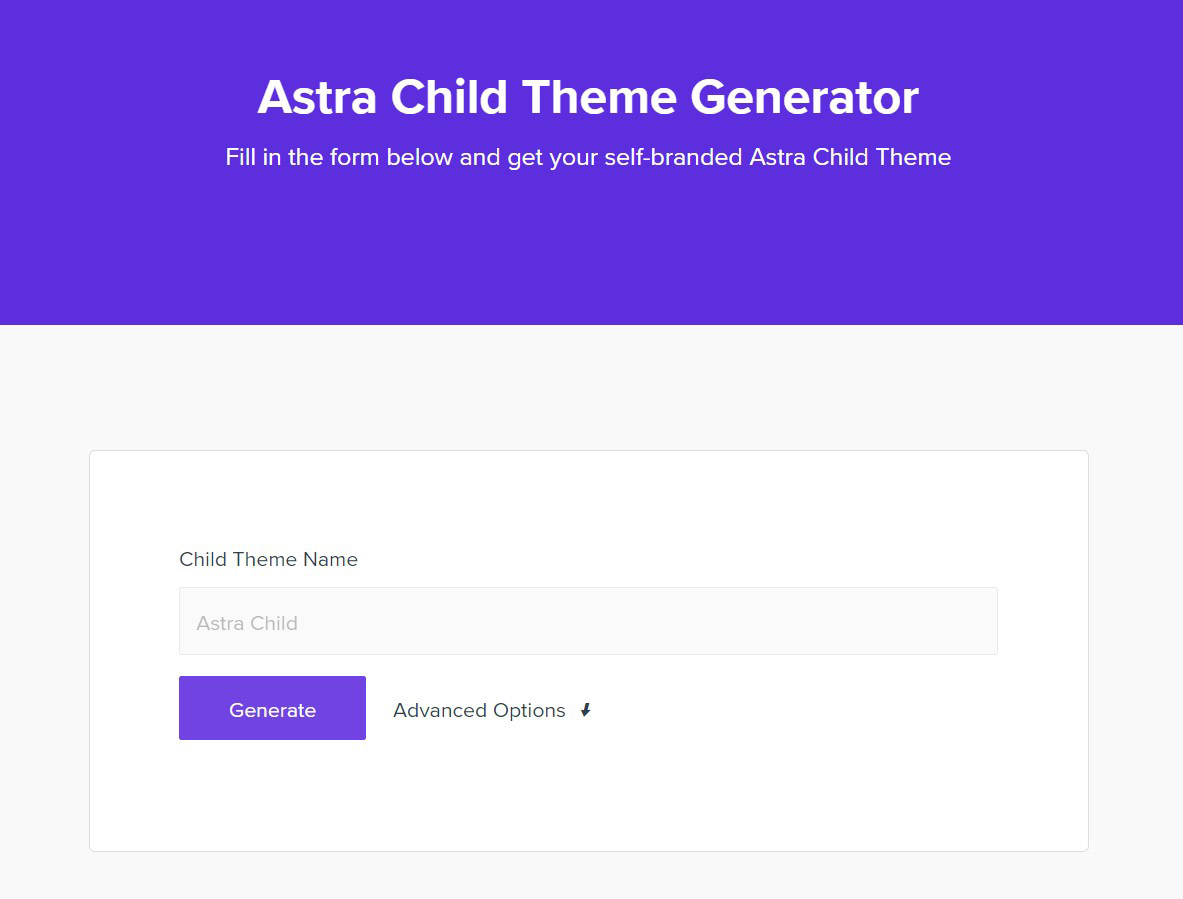
Otherwise, you can use a free plugin like Child Theme Configurator.
How To Update A WordPress Theme
Once you’ve installed your WordPress theme, you can update it by going to Appearance → Themes:

If you purchased a premium theme, you’ll typically need to enter your license key before you can use this automatic update interface.
How To Change A WordPress Theme?
To change a WordPress theme, you can go to Appearance → Themes. You can switch to any one of the themes that you’ve installed at your site:
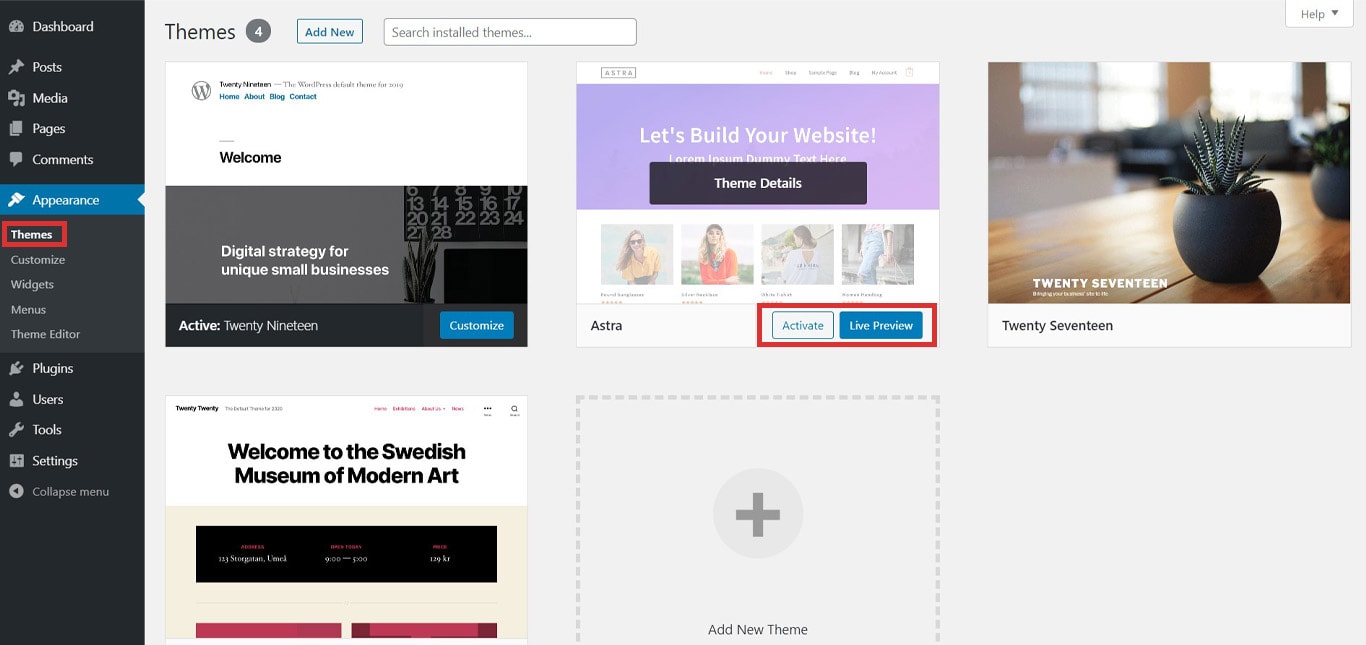
If you chose a theme that separates design from functionality (as it should), you shouldn’t experience issues when changing your theme. But if you did pick a theme with its own built-in shortcode or page builder, all of that content will stop working once you change themes.
For those reasons, it’s always a good practice to double-check important functionality whenever you change themes.
That’s How To Choose A WordPress Theme That You’ll Love
Congrats! You just learned how to choose a website theme that will set you up for success both now and in the future.
If you want to see a theme that meets all of the criteria above, we encourage you to learn more about how Astra can help you create…well, pretty much any type of WordPress site!
To keep things simple, we have articles on the best WordPress themes. Check that out!
And no matter which theme you choose, we wish you the best of luck with your new site!
Disclosure: This blog may contain affiliate links. If you make a purchase through one of these links, we may receive a small commission. Read disclosure. Rest assured that we only recommend products that we have personally used and believe will add value to our readers. Thanks for your support!
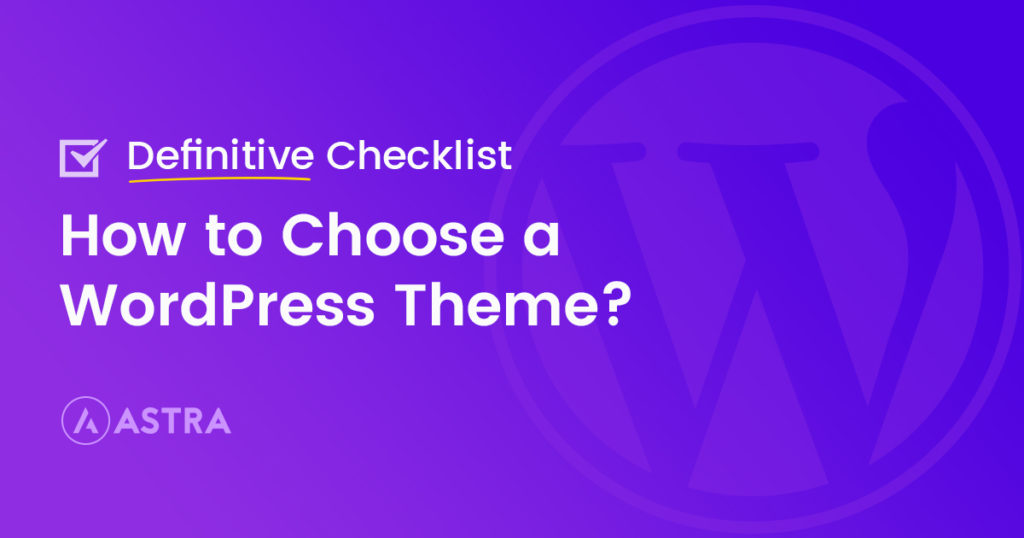
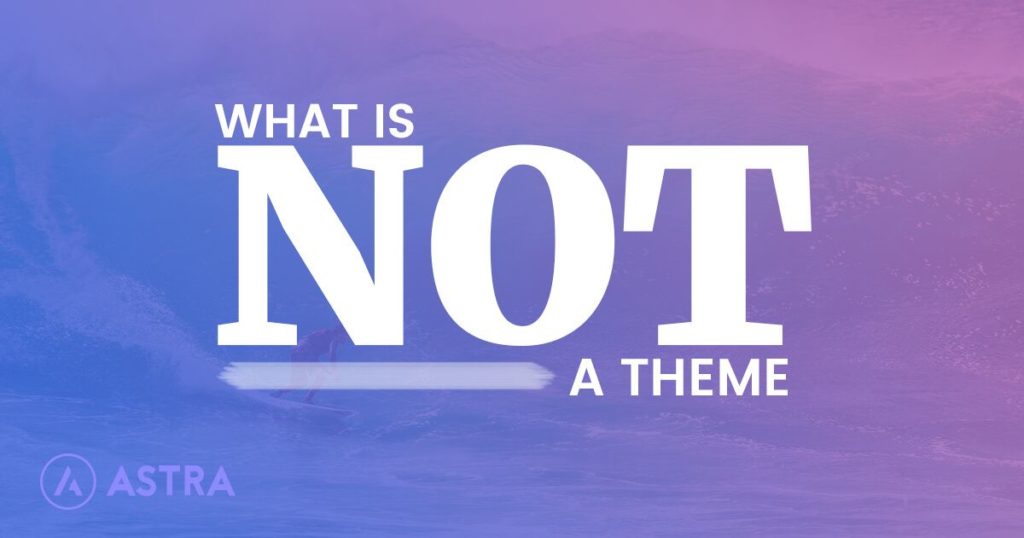
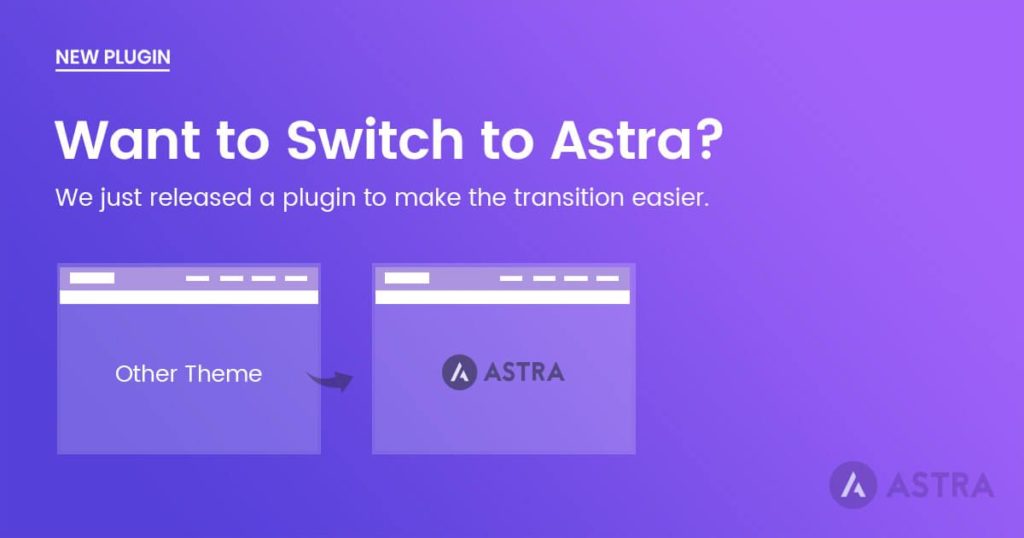

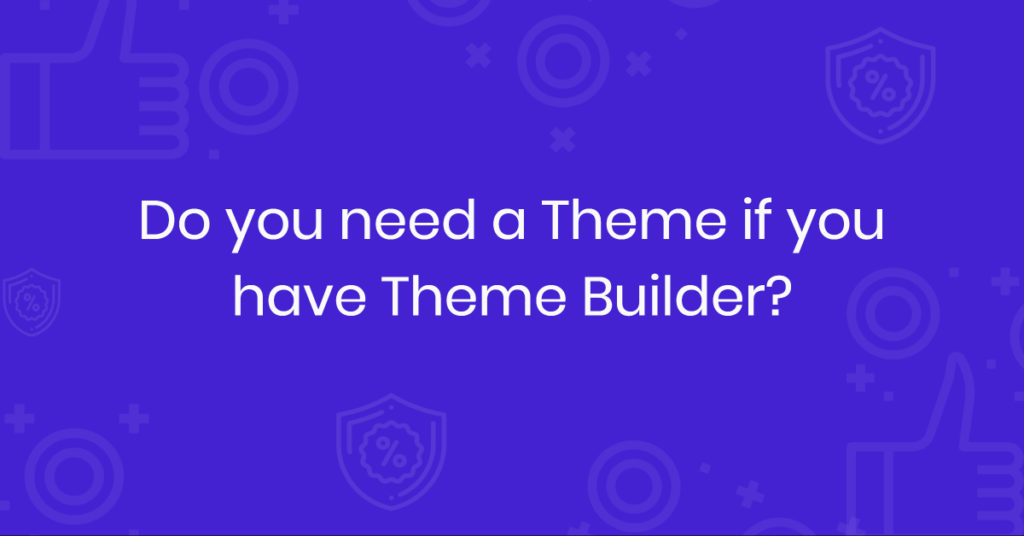

Thanks so much for all the information. It’s interesting for a freelance to know all this things
Great article, Sujay! It may be difficult for people to choose the perfect WordPress theme, but the truth is that it’s one of the most important things they need to choose. The design of their website represents their business online, so making it attractive, easy-to-use, and well-structured is really crucial for providing good user experience. According to research conducted by the web marketing company Corona, 48% of people consider website design the number one factor for deciding the credibility of a business.